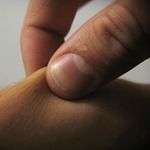It seems Apple isn't making many friends over at the patent examiner's office lately - yet another high-profile patent used by the company in litigation has been deemed wholly invalid on a preliminary basis.
The patent in question is often called the "pinch-to-zoom" patent, because that's basically what it patents - a pinch gesture to zoom in on content on a display. This patent had been used successfully by Apple during the first Samsung lawsuit, with numerous (all but two) Samsung devices found to infringe it. The claim (#8) involved in the suit, below (heavily redacted, reformatted):
determining whether the event object invokes a scroll or gesture operation by distinguishing between a single input point applied to the touch-sensitive display that is interpreted as the scroll operation and two or more input points applied to the touch-sensitive display that are interpreted as the gesture operation;
issuing at least one scroll or gesture call based on invoking the scroll or gesture operation;
responding to at least one scroll call, if issued, by scrolling a window having a view associated with the event object;
and responding to at least one gesture call, if issued, by scaling the view associated with the event object based on receiving the two or more input points in the form of the user input.
That all probably sounds like gibberish. Let me break down what's going on here. This is a patent on the concept of a touch heuristic (yes, another pesky vague and overarching software patent that probably shouldn't be patentable in the first place), in which a touchscreen device first decides if you're touching it with one or two fingers.
Next, if you're using one finger on the display content, and then move that finger, it scrolls the content (presumably along the X and/or Y axes).
But, if it detects two fingers, it then scales the view based on the amount of input received - aka pinch-to-zoom. So this is a patent not on the concept of pinch to zoom, per se, but on the concept of a touch heuristic that knows when the user wants to zoom versus scroll, by examining the number of fingers touching the display.
Anyway, as with all initial invalidation findings, this is preliminary - and subject to change. Apple could negotiate to narrow its patent, or it could just choose to challenge the finding entirely (more likely). And those challenges can go on for well over a year. Still, yet another Apple software heuristic patent that apparently isn't quite so obviously patentable after a second look - such a losing streak at the USPTO can't be encouraging.
AppleInsider, Rejection Notice (PDF) via The Verge

